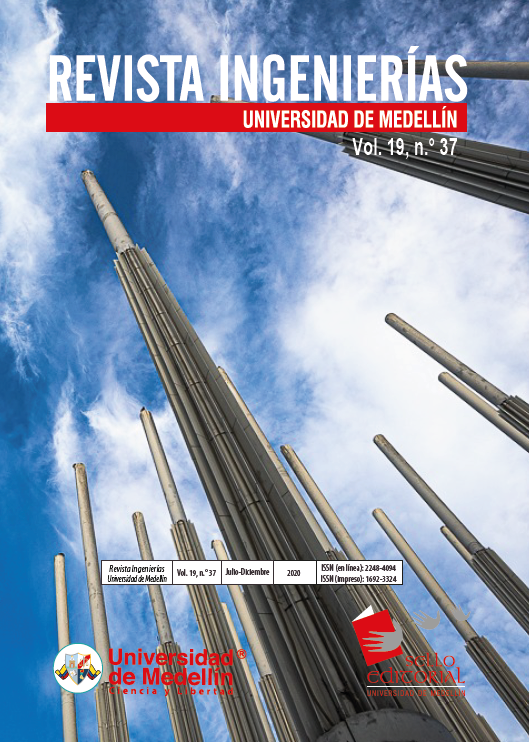Current-Voltage Characteristics of a Self-Assembled DNA
Main Article Content
Abstract
In this work, we numerically investigate the transport properties of two-dimensional square lattice patterns built from a telomeric DNA sequence, using an effective tight-binding model for the electronic structure, while the current is obtained within a Green’s function framework. We show that the self-assembled DNA structures based on telomeric DNA strands have current-voltage (I-V) characteristics, which make the system eligible for nanoelectronic applications.This paper shows a research on the transport properties of two-dimensional square lattice patterns built from a telomeric DNA sequence. A tight-binding model, and the recursive Green’s function method were used. It is showed that the self-assembled DNA structures based on telomeric DNA strands have current-voltage (I-V) characteristics, with robust plateau structures that favor the scrutiny of DNA-lead, as well as interference effects. An increase of the current, dependent on the distance between the crosses in the self-assembled square lattice structures, is observed, which makes the system eligible for nanoelectronic applications.
Article Details
References
[1] N. C. Seeman, and H. F. Sleiman, 'DNA nanotechnology,' Nature Reviews Materials, vol. 3, p. 17068, 11 2018. DOI: 10.1038/natrevmats.2017.68.
[2] N. C. Seeman, 'DNA in a material world,' Nature, vol. 421, no. 6921, p. 427, 2003. DOI: 10.1038/nature01406.
[3] G. M. Whitesides, and B. Grzybowski, 'Self-assembly at all scales,' Science, vol. 295, no. 5564, pp. 2418-2421, 2002. DOI: 10.1126/science.1070821.
[4] J. R McMillan et al., 'Protein Materials Engineering with DNA' Acc. Chem. Res vol. 52, no. 7, p. 1939, 2019. DOI: 10.1021/acs.accounts.9b00165.
[5] J. Nangreave, D. Han, Y. Liu, and H. Yan, 'DNA origami: a history and current perspective,'Current Opinion in Chemical Biology, vol. 14, no. 5, p. 608, 2010. DOI: 10.1016/j.cbpa.2010.06.182.
[6] A. Mangalum, M. Rahman, and M. L. Norton, 'From DNA Nanotechnology to Material Systems Engineering' advanced materials, vol. 31, p. 1806294, 2019. DOI: 10.1002/adma.201806294.
[7] J. Y. Kishi, T. E. Schaus, N. Gopalkrishnan, F. Xuan, and P. Yin, 'Programmable autonomous synthesis of single-stranded DNA,' Nature Chemistry, vol. 10, p. 155, 2017. DOI: https://doi.org/10.1038/nchem.2872
[8] X. Liu, F. Zhang, X. Jing, M. Pan, P. Liu, W. Li, B. Zhu, J. Li, H. Chen, L. Wang, J. Lin, Y. Liu, D. Zhao, H. Yan, and C. Fan, 'Complex silica composite nanomaterials templated with DNA origami,' Nature, vol. 559, no. 7715, p. 593, 2018. DOI: https://doi.org/10.1038/s41586-018-0332-7
[9] T. Lin, J. Yan, L. L. Ong, J. Robaszewski, H. D. Lu, Y. Mi, P. Yin, and B. Wei, 'Hierarchical assembly of DNA nanostructures based on four-way toehold-mediated strand displacement,' Nano Letters, vol. 18, no. 8, p. 4791, 2018. DOI: https://doi.org/10.1021/acs.nanolett.8b01355
[10] D. Y. Tam, X. Zhuang, S. W. Wong, and P. K. Lo, 'Photoresponsive self-assembled DNA nanomaterials: Design, working principles, and applications,' Small, vol. 15, no. 26, p. 1805481, 2019. DOI: 10.1002/smll.201805481.
[11] Y. Li, and R. Schulman, 'DNA nanostructures that self-heal in serum,' Nano Letters, vol. 19, no. 6, p. 3751, 2019. DOI: 10.1021/acs.nanolett.9b00888.
[12] C. Páez, and P. Schulz, 'Electronic localization at mesoscopic length scales: different definitions of localization and contact effects in a heuristic DNA model,' Eur. Phys. J. B, vol. 86, p. 104, 2013. DOI: 10.1140/epjb/e2013-30728-9.
[13] R. Gutiérrez, S. Mandal, and G. Cuniberti, 'Quantum transport through a DNA wire in a dissipative environment,' Nano Letters, vol. 5, no. 6, p. 1093, 2005. DOI: 10.1021/nl050623g.
[14] C. J. Páez, and P. A. Schulz, 'Delocalization of vibrational normal modes in double chains: Application to DNA systems,' Microelectronics Journal, vol. 39, no. 11, p. 1222, 2008. DOI: 10.1016/j.mejo.2008.01.007.
[15] C. J. Páez, P. A. Schulz, N. R. Wilson, and R. A. Roemer, 'Robust signatures in the current-voltage characteristics of DNA molecules oriented between two graphene nanoribbon electrodes,' New Journal of Physics, vol. 14, no. 9, p. 093049, 2012. DOI: 10.1088%2F1367-2630%2F14%2F9%2F093049.
[16] C.-T. Shih, S. Roche, and R. Roemer, 'Point-mutation effects on charge-transport properties f the tumor-suppressor gene p 53,' Physical review letters, vol. 100, p. 018105, 02 2008.
DOI: 10.1103/PhysRevLett.100.018105.
[17] C. J. P´aez, R. Rey-Gonz´alez, and P. A. Schulz, 'Macroscopic localization lengths of vibrational normal modes in a heuristic DNA model,' Phys. Rev. B, vol. 81, p. 024203, Jan 2010. DOI: 10.1103/PhysRevB.81.024203.
[18] S. A. Wells, C.-T. Shih, and R. A. Römer, 'Modelling charge transport in DNA using transfer matrices with diagonal terms,' vol. 23, p. 4138, 2009. DOI: 10.1142/S0217979209063328.
[19] J. Rak, A. Voityuk, A. Márquez, and N. Rösch, 'The effect of pyrimidine bases on the hole-transfer coupling in DNA,' vol. 106, no. 32, p. 7919, 2002. DOI: 10.1021/jp014261m.
[20] M. P. L. Sancho, J. M. L. Sancho, J. M. L. Sancho, and J. Rubio, 'Highly convergent schemes for the calculation of bulk and surface green functions,' Journal of Physics F: Metal Physics, vol. 15, no. 4, p. 851, 1985. DOI: 10.1088%2F0305-4608%2F15%2F4%2F009.
[21] N. B. Larsen, H. Biebuyck, E. Delamarche, and B. Michel, 'Order in microcontact printed self-assembled monolayers,' Journal of the American Chemical Society, vol. 119, no. 13, p. 3017, 1997. DOI: 10.1021/ja964090c.
[22] D. Porath, A. Bezryadin, S. De Vries, and C. Dekker, 'Direct measurement of electrical transport through DNA molecules,' vol. 403, p. 635, 2000. DOI: 10.1038/35001029.
[23] H. Cohen, C. Nogues, R. Naaman, and D. Porath, 'Direct measurement of electrical transport through single DNA molecules of complex sequence,' vol. 102, p. 11589, 2005. DOI: 10.1073/pnas.0505272102.
[24] C. Lewenkopf, and E. Mucciolo, 'The recursive green’s function method for graphene,' Journal of Computational Electronics, vol. 12, no. 203, p. 203, 2013. DOI: 10.1007/s10825-013-0458-7.





